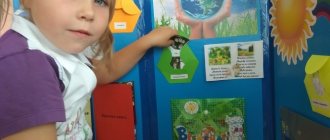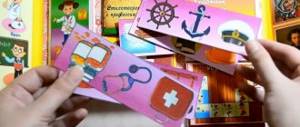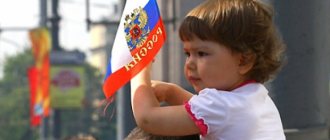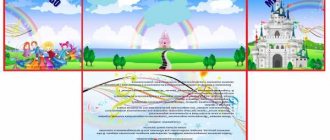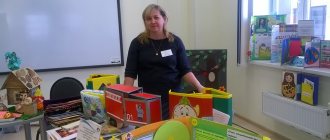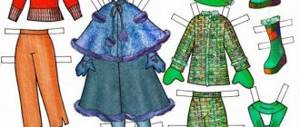Who prepares the manual
A laptop on the topic “Theater” is usually compiled by a teacher: the teacher himself selects the materials and the method of preparing the manual. However, given the age of the children, children can also take part in the preparation of the interactive book. For example, choosing illustrations for decoration, gluing pictures. In addition, parents should be involved in the creative process. For example, to search for riddles, puzzles, and compose crosswords on a topic.
In the preparatory group, children together with their parents can be given a project assignment “Theater Professions”, the essence of which is to search for materials about specialties that are in one way or another related to the theater, and the children can also draw and make applications on the topic.
Children can create applications and drawings on a theatrical theme to decorate a lapbook or to complete a separate block “Our Creativity”
What you need to know about making a lapbook
Designing a lapbook is an exclusively creative process, which is completely left to the imagination of the compilers. Typically, the basis for the manual is cardboard or plastic folders, bound into one folding book, which can be used as a screen for a finger theater. The outer flaps of the cardboard clamshell can be cut out in the form of an assembled curtain.
As for organizing information, these can be accordion books, paper pockets or envelopes made from thin plastic folders of various formats.
The manual materials can be divided into several blocks:
- informational;
- visual;
- game;
- productive, that is, it implies that children draw, sculpt or stage mini-plays of finger theater using templates of paper dolls.
These blocks are not presented separately, but in combination with each other. For example, textual information about the rules of behavior in the theater is illustrated with pictures.
The content of the lapbook is determined by the goals and objectives of studying the topic in a particular group.
Table: features of the content of the lapbook for middle and senior preschool age
| Block | The essence | Nuances of lighting in different groups |
| Informational | Includes basic information about the theater, performances and people whose professions are related to the performing arts. | In the middle group, children get acquainted with types of theater (puppet, drama, opera and ballet), the structure of the theater (auditorium, stage, dressing rooms, etc.), rules of behavior in the theater. Practice skills in expressing and verbally defining feelings and emotions to illustrate a particular situation. For example, the lotto game “Theater of Moods” (children take an emoticon picture, determine for which situations this mood is suitable and why). |
| In the older group, children expand their understanding of the types of theater (for example, about the varieties of puppet theater: bibabo puppet theater, marionette dolls, apron puppets, etc.), generalize the rules of behavior in the theater, and become familiar with professions that cannot be avoided in the theater ( make-up artist, decorator, artist, costume designer). | ||
| They get acquainted with the history of the development of the theater and generalize what they have learned previously. | ||
| Fiction | It implies the inclusion in the manual of texts for staging paper finger theater, as well as plots related to acquaintance with the art of theater. | For productions in the middle group, fairy tales “Turnip” and “Kolobok” are included. As texts for discussion, you can use “In the Nursery” by G.X. Andersen. Questions to the text:
|
| For productions in older preschool age, “Teremok”, “The Wolf and the Seven Little Goats”, “The Three Little Pigs” are added. To get acquainted with the structure of the theater - excerpts from A. Tolstoy’s fairy tale “The Golden Key”, as well as V. Kataev’s story “Theater”. | ||
| Poems | They help to update existing knowledge on the topic, as well as introduce new material and consolidate what has been learned. | In the middle group, poems can be the basis of an information block, for example, A. Barto’s work “In the Theater,” which describes the first acquaintance with the theater. For older preschoolers, you can use V. Berestov’s cycle “In the Puppet Theater” as poetic material, where the children learn about the purpose of each participant in the theatrical performance. |
| Puzzles | In the middle group, riddles are selected with answers that rhyme. As for the subject matter, it concerns theater in general. In older preschool age, riddles can be included in cycles: about theatrical professions, about types of theater. | |
| Visibility | Used to make the lapbook attractive, as well as to illustrate materials on the topic. The manual may include a CD with cartoons/or videos on the topic, which the children watch and then discuss. | Working with visual materials includes writing descriptions of pictures (4–6 sentences in the middle group, 6–8 in the senior group and 8–10 in the preparatory group). In addition, the lapbook includes pictures for acting out scenes with finger puppets and on flannelgraph. |
| Games | The game block of the manual includes visual materials and brief descriptions of the conditions of didactic, theatrical and outdoor games on the topic. | |
| Templates for coloring | Used to summarize what has been learned, consolidate and repeat material. And usually as materials for independent work. | In the middle group, the templates are images of individual elements associated with the theater (for example, a stage with a curtain, an auditorium, a theater building), and in older preschool age, the coloring pages are of a plot nature (for example, scenes from fairy tale productions in a puppet theater). |
| Puzzles, crosswords | Solving puzzles and crosswords requires knowledge of letters and basic writing skills, which is why these materials are included in manuals for older preschoolers. For older preschoolers, you can add “Find the Differences” themed pictures to the block with puzzles. | |
Video: cartoon “Theater” from the “Smeshariki” series
Video: cartoon “All life is theater” from the series “Masha and the Bear”
Video: a story about the Bolshoi Theater in the cartoon “Houses”
For what age is a lapbook about your hometown suitable?
A laptop about your hometown will be relevant already in the middle group. It is at this age that the teacher begins to expand the patriotic concepts of preschoolers, moving from the topic of family (love and respect for members of one’s family - the initial stage of patriotic education) to the topic of learning about the small homeland. As children grow older, the manual will become more complex in terms of content and filled with new information.
In the middle group, the teacher begins to develop in the children an interest in their small homeland, so a lapbook on this topic will already be relevant
A bank of materials for a lapbook dedicated to the theater
The teacher focuses the content of the lapbook on the requirements of the Federal State Educational Standard, the work program in the context of the topic under consideration, as well as the level of development of the children in the group and their range of interests. So, if children in the preparatory group are keen on puzzles, then this block can be expanded.
Information block
To get acquainted with the theater, its structure, and theatrical professions, you can use materials collected by teacher M.A. Sorokina. "What is theater." Examples of materials on the history of the theater, its types, as well as an information block for getting acquainted with the structure of the theater building, artistic design, and timing features of the performance can be found here.
Poems
The selection may include:
- S. Marshak “In the theater for children”;
- The theater world will open its scenes to us, And we will see miracles and fairy tales. There is Pinocchio, Basilio the cat, Alice. Heroes and masks can be easily changed. The magical world of games and adventures, any kid wants to visit here. Suddenly she will turn into Cinderella or a prince, And show everyone her talents. The theater, like a sorcerer, a wizard, holding his magic wand, And now a child, modest and shy, Today suddenly plays a king. Let childhood be like a fairy tale, Let miracles happen every moment, And let the world around become kind and affectionate, Let good triumph over evil again! (T. Grigorieva);
- Today my mother and I have a cultural program. Give me your hand, mom, Let's go to the puppet theater! I know that I’m big, but I love dolls. I look and can’t understand, How can a doll be controlled? I took the mitten and put it on And then the Cockerel began to sing, And you changed the mitten and he turned into a Fox! But I know for sure - The actor’s hand works, And the doll comes to life, Sings, experiences this transformation Magically! And mom looks with admiration. And we’ll go to the theater, and we’ll take dad with us! (N. Sokolova).
Puzzles
For the average group, the selection could be like this:
- Who is a lover of performances, Has looked through their darkness, quite a few, Who is an admirer of the theater - He is called... (Theater-goer);
- The artists work there And the spectators clap for them. The performance in the circus is in the arena, Where in the puppet theater? - On the stage);
- There is a barrier on the stage, Surprisingly beautiful! Made by a craftsman - not by a company, but what is it called? - Just... (with a screen).
For older preschool age, riddles can be grouped into cycles.
About theatrical professions:
- He walks around the stage, jumps, He laughs, he cries! If he portrays anyone, he will amaze everyone with his skill! And the type of profession has been formed for a long time - ... (Actor);
- He leads everyone, thinks, runs, screams! He inspires the actors, He directs the entire performance, Like a conductor of an orchestra, But his name is... (Director);
- In the design of the face - Wigs, coloring, And hairpieces, and extensions, And stickers, masks - This is all you need for makeup, You need everything, without a doubt.
- We need a make-up master - an artist... (make-up artist).
About the structure of the performance:
- The performance was a great success and the audience was all happy! The artist receives a special ovation for the colorful... (Scenery);
- If you want to become different, Call for help... (Makeup);
- Everything you see on stage: What lies, hangs, stands, All the objects of the performance - This, you know, is... (Props);
- There is a barrier on the stage, Surprisingly beautiful! Made by a craftsman - not by a company, but what is it called? - Just... (with a screen).
Games
The basis of the game block in the “Theater” lapbook will be theatrical games.
Table: examples of theater-themed lapbook games
| Name | Type of game | Game conditions | What age is it aimed at? |
| "Tricky Little Animal" | Theatrical |
| Middle, senior |
| "Make a gesture" | Theatrical |
| Middle, senior |
| "Boastful Hare" | Theatrical |
| Middle, senior |
| Lotto "View of the Theater" | Didactic |
| Senior |
| "We're playing theater" | Didactic |
| Middle, senior |
| "Friendly family" | Movable with theatrical elements |
| Senior (preparatory group) |
| Fox Alice and Cat Basilio |
| Middle, senior |
Photo gallery: materials for the game “Playing Theater”
Children guess the director by expressive movements
Without good lighting the performance will not take place
The costume designer's job involves choosing outfits for the characters.
Actors must completely transform into the role.
Puppeteers control the puppets and play themselves
In the hands of puppeteers, puppets come to life
The illuminator responds to the serviceability of all lighting fixtures
The stage is where the actors work
The costumer can find any outfit that is in the costume room
The director's chair can be on or near the stage
Photo gallery: themed templates for coloring
In the middle group, the guys paint individual elements directly related to theatrical art
A coloring page with a ballerina can be an illustration of studying a topic related to types of theater
In older preschool age, the emphasis is on coloring plot compositions with a large number of details
While coloring, the kids come up with names for the characters.
To color Pierrot's white robe, you can use white gouache
To add brightness to the image of Parsley, you can use wax crayons for coloring.
An additional task for coloring can be writing a story about the fate of the puppet
Photo gallery: samples of rebuses, crosswords, puzzles on a theatrical theme
Children can find differences at speed
Answer: opera
Answer: curtain
Crosswords can be a project activity on a topic for children and parents
How to use the guide
A laptop is convenient for working not only in kindergarten, but also at home. Moreover, the ways of working with it in both cases can be very diverse:
- to familiarize yourself with the topics “Theater”, “Theater professions”, “Rules of behavior in the theater”;
- to practice acquired knowledge in memorizing rhymes, guessing riddles, coloring thematic pictures;
- as a way to organize individual work with children.
In kindergarten classes, lapbooks can be used partially, for example, using the game “Playing Theater” when summarizing what has been learned on a relevant topic. Or you can completely build a GCD based on it, using riddles to update knowledge on the topic at the introductory stage, turning to games and tasks to describe pictures at the main stage and summarizing, generalizing the material with puzzles, crosswords, coloring books at the final stage.
In addition, a theatrical lapbook helps organize group creative work on a topic.
Group work is based, first of all, on developing the ability to cooperate in the process of theatrical activities
Lapbook “The city where I live. Saint Petersburg"
Author: Vasilyeva Svetlana Viktorovna
teacher of GBDOU kindergarten No. 24 of Primorsky district of St. Petersburg
Lapbook “The city where I live. Saint Petersburg"
“Supporting the cultural development of a child in the process of familiarization with the history and culture of the city “Meeting with the City””
Methodological development to support the cultural development of a child in the process of familiarization with the history and culture of the city. “Making an interactive LAPBUK folder on the topic “The city where I live - St. Petersburg”
Author and developer: Vasilyeva Svetlana Viktorovna, teacher of the State Budgetary Educational Institution kindergarten No. 24 of the Primorsky district of St. Petersburg.
In order to meet modern requirements, teachers of preschool educational organizations need to constantly study, engage in self-education, and improve their level of professional competence. It is also important to learn to respond to ongoing changes in the field of education, to be able to work in a team of like-minded people, to competently and efficiently organize educational work with children, to effectively build partnerships with their parents to solve educational problems, to independently select the content of education and adapt it taking into account age and individual characteristics of children of a particular group, focusing on the requirements of the Federal State Educational Standard for preschool education. In this regard, teachers are faced with the task of finding new non-standard forms of interaction with students. Traditional education is being replaced by productive learning, which is aimed at developing creative abilities and developing interest in creative activities in preschoolers.
One of the promising methods that promotes the cultural development of a child in the process of familiarization with the history and culture of the city is the creation of a lapbook on the topic “The city where I live - St. Petersburg”
Goal: Expanding children's knowledge and ideas about their hometown, increasing cognitive interest in the city of St. Petersburg, its history and attractions.
Pedagogical intent:
- Fostering a caring, friendly, caring attitude towards your city and historical monuments. Formation of skills of cooperation, initiative, mutual understanding. Contributing to the formation of ethical behavior of St. Petersburg residents.
- Introducing children to the concept “my hometown is St. Petersburg.” Expanding children's understanding of their hometown. Familiarization with the history of its origin, the name of the founder, and the coat of arms. To consolidate the idea of our city as a cultural center and its main attractions.
- Expanding the vocabulary by including nouns (city, fortress, angel, cathedral, passenger transport, spire, guide, excursion, St. Petersburger). Developing the ability to tell a coherent, complete and expressive story, and to use figurative words and expressions. Improving monologue and dialogic speech.
- Promoting the formation of aesthetic feelings. Development of fantasy and creative imagination.
A laptop is a universal guide that can be the result of children’s project-based and independent activities, a thematic week provided for by the main educational program of a preschool educational organization. Can be used in the implementation of any of the educational areas, ensuring their integration. A laptop is a relatively new teaching tool; it is a folding book with pockets, doors, windows, tabs and moving parts, in which materials on one topic are placed.
Stages of creating a lapbook.
Stage I: Choosing the topic “The city where I live - St. Petersburg”
At the preparatory stage, the topic of the project is selected and formulated. The object, the subject of the project, the hypothesis are determined. The literature on the research problem is studied.
Stage II: Plan for the topic “The city where I live - St. Petersburg”
- Symbols and landmarks
- Find out by silhouette
- Coloring pages
- Puzzles
- Mnemotables of verses
- Puzzles
- My region
- Transport
- Seasons
Stage III: Layout
- Pockets
- Envelopes
- Rotating Books,
- circles
- accordion books
- Notebook with cut pages of different lengths
- Leaf folded in two or four times
- Strip folded several times
What you need to make a lapbook:
- A3 format folders or base cardboard from which you can make your own. To strengthen the base, I used plastic sheets that have hygienic certificates; the sharp corners were cut off and rounded.
- White, colored paper, pictures, printed templates.
- Scissors, fasteners.
- Glue stick.
- Stapler, tape.
- Colored pencils, markers, multi-colored pens
A laptop on the topic “The city where I live is St. Petersburg” as one of many methods for supporting the cultural development of a child in the process of familiarizing himself with the history and culture of the city.
- Helps to organize information on the topic being studied at will and to better understand and remember the material.
- This is a great way to review what you've learned. At any convenient time, the child simply opens the laptop and happily repeats what he has learned, looking at the book.
- The child learns to independently collect and organize information.
- Creating a lapbook is one of the types of joint activities between adults and children. It can also be a form of presenting the results of a project or a thematic week.
- A laptop can be a meaningful element of a group’s developing subject-spatial environment.
- A laptop can be used as a special type of parent-child project.
Lapbook “The city where I live. Saint Petersburg"



